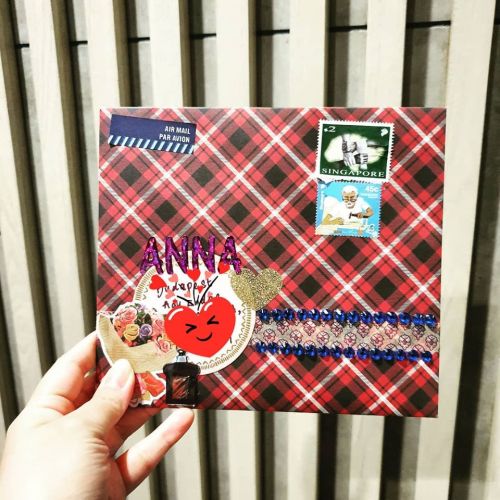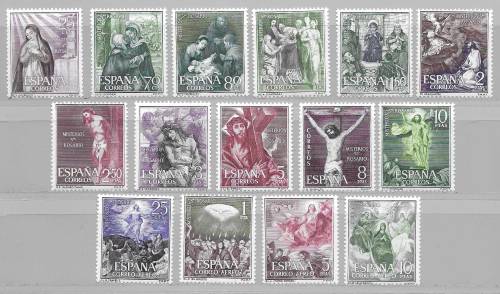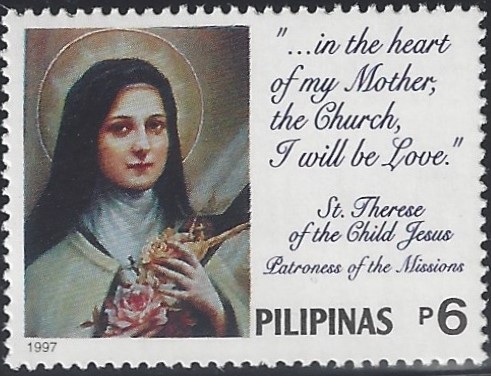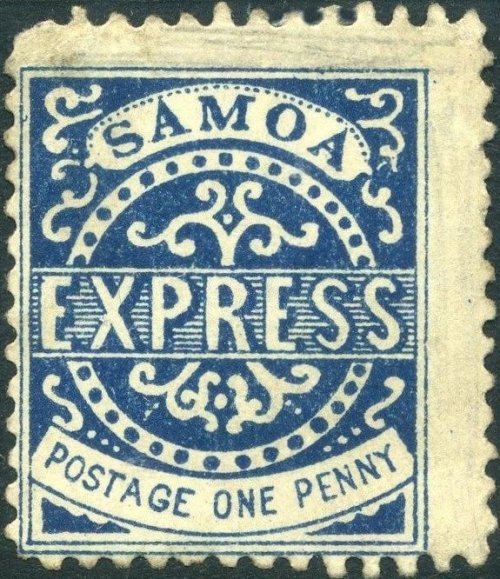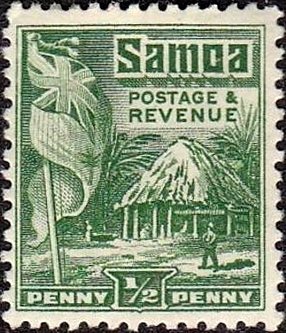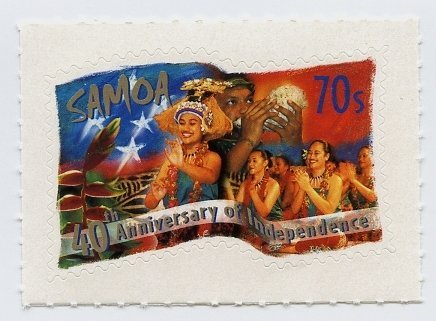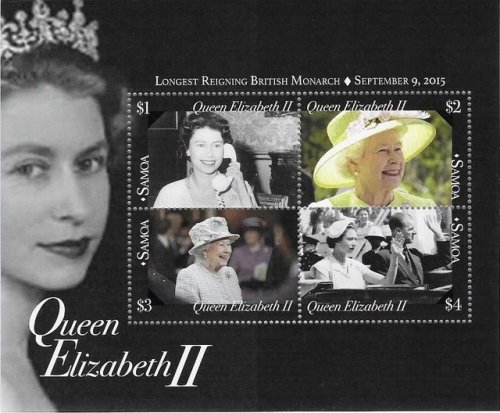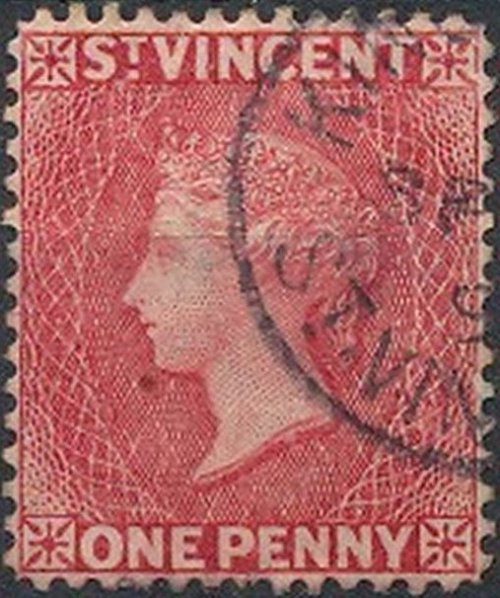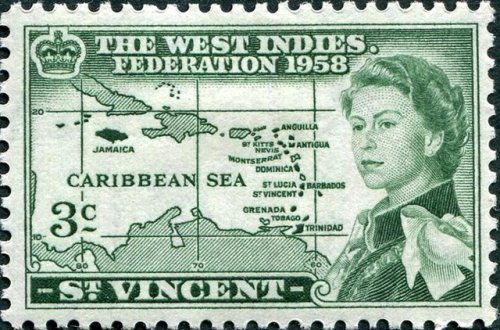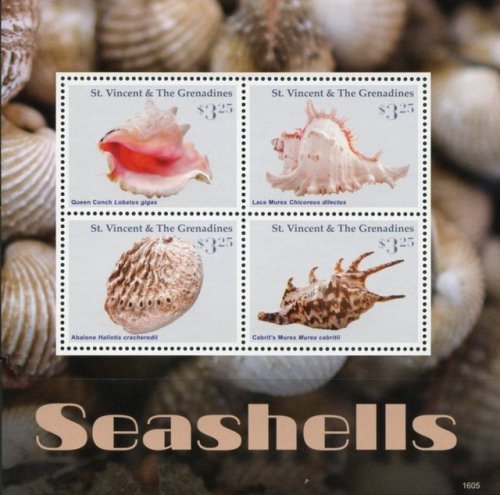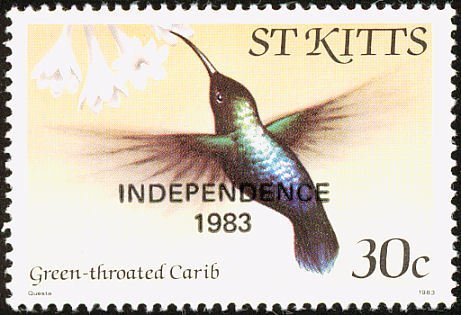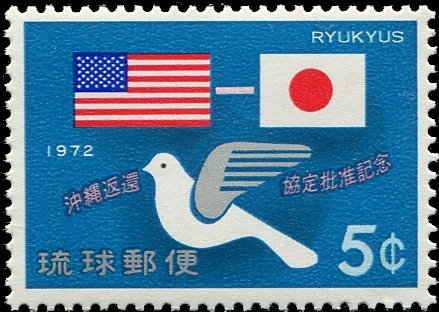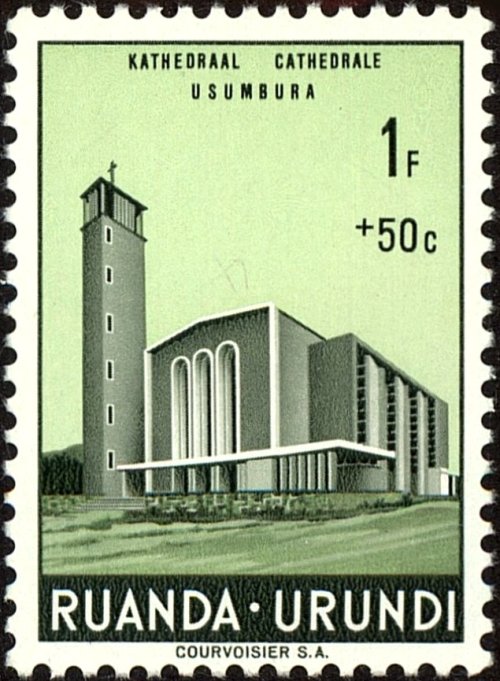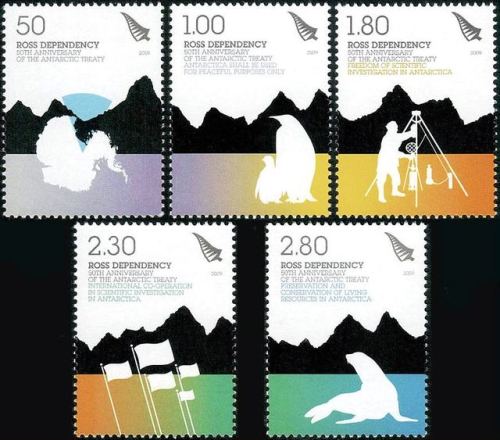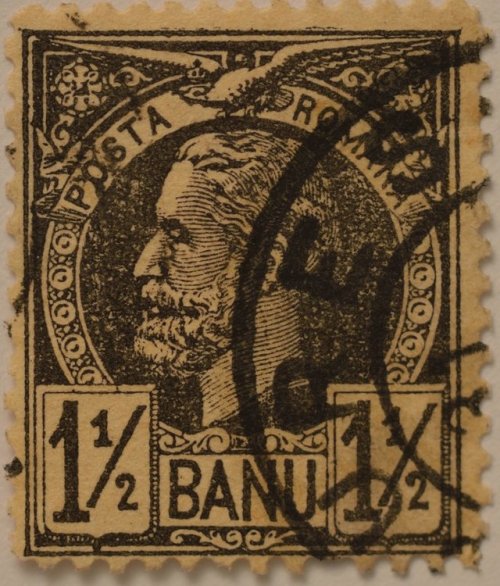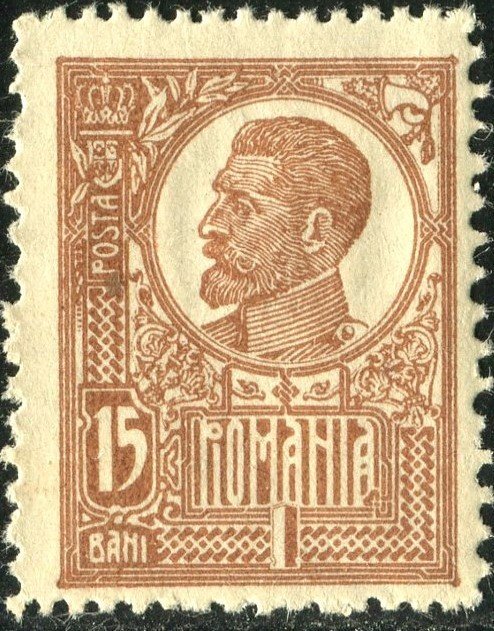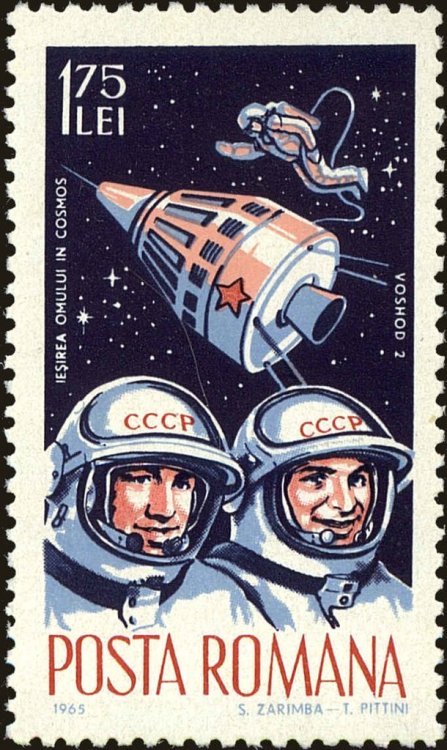#philately
TheMysteries of the Rosary
Spain, 1962~ The Joyful Mysteries~
The Annunciation (Luke 1:30-31)
The Visitation (Luke 1:42-43)
The Nativity of Our Lord (Luke 2:7)
The Presentation of Christ (Luke 2:22-23)
The Finding of the Child Jesus in the Temple (Luke 2:46)~ The Sorrowful Mysteries ~
The Agony in Gethsemane (Luke 22:44-45)
The Scourging at the Pillar (Mark 15:15)
The Crowning with Thorns (Matthew 27:28-29)
The Carrying of the Cross (John 19:17)
The Crucifixion (Luke 23:46)~ The Glorious Mysteries ~
The Resurrection (Matthew 28:5-6)
The Ascension (Mark 16:19)
The Descent of the Holy Spirit (Acts 2:4)
The Assumption (1 Thessalonians 4:14-17)
The Coronation (Revelation 12:1)A WAY OF COMMEMORATING THE LIFE, DEATH & GLORY OF JESUS & MARY IN THE MOST HOLY ROSARY,
& A WAY TO CURB OUR IMAGINATION & TO LESSEN DISTRACTIONS
In order to do this, we must add a word or two to each Hail Mary (depending upon the decade) and this will help remind us which mystery we are commemorating. This word or words should be added after the word “Jesus.” “And blessed is the fruit of Thy Womb”;
At the 1st Decade … . . “Jesus incarnate”;
At the 2nd “ … . . “Jesus sanctifying”;
At the 3rd “ … . . "Jesus born in poverty”;
At the 4th “ … . . "Jesus sacrificed”;
At the 5th “ … . . "Jesus, Saint among Saints”;
At the 6th “ … . . "Jesus in His agony”;
At the 7th “ … . . "Jesus scourged”;
At the 8th “ … . . "Jesus crowned with thorns”;
At the 9th “ … . . "Jesus carrying His Cross”;
At the 10th “ … . . "Jesus crucified”;
At the 11th “ … . . "Jesus risen from the dead”;
At the 12th “ … . . "Jesus ascending to Heaven”;
At the 13th” … . . “Jesus filling Thee with the Holy Spirit”;
At the 14th “ … . . “Jesus raising Thee up”;
At the 15th “ … . . "Jesus crowning Thee.”
At the end of the first five mysteries, we say:
“Grace of the Joyful Mysteries, come down into our souls and make them really holy”;
At the end of the second:
“Grace of the Sorrowful Mysteries, come down into our souls and make them truly patient”;
And at the end of the third:
“Grace of the Glorious Mysteries, come down into our souls and make them everlastingly happy. Amen.”~ St Louis de Montfort, The Secret of the Rosary
Post link
Saint Thérèse of the Child Jesus and the Holy Face
Thérèse of Lisieux (2 January 1873 – 30 September 1897)
The Philippines, 1997Feastday: 1 October
Started a new blog dedicated to the Catholic faith expressed through postage stamps!
Post link
At the fifth smallest country in the world, San Marino also has the distinction of being one of only three nations completely surrounded by another nation (Vatican City and Lesotho being the other two) and of being the only nation on earth where cars outnumber people. Named after the Third Century Roman/Croatian stonemason Saint Marinus, San Marino also likes to think of itself as being the oldest extant sovereign state as well as the oldest constitutional republic, in addition to having the earliest written governing documents still in effect (the Constitution of San Marino, established in the 16th Century). Packs a lot of punch, does our Most Serene Republic.
Stamp details:
Stamp on top:
Issued on: August 1, 1877
From: San Marino, Republic of San Marino
MC #2
Stamps on bottom:
Issued on: November 11, 2000
From: San Marino, Republic of San Marino
MC #1925-1928
Recognized as a sovereign state by the UN: Yes (since March 2, 1992)
Official name: Most Serene Republic of San Marino; Serenissima Repubblica di San Marino
Member of the Universal Postal Union: Yes (since July 1, 1915)
Post link
Samoa has the distinction of being the first formerly colonized nation in the Pacific to gain independence - in 1962 from the British/New Zealand. Prior to that, it had been under German control there for a while, with the UK and USA bickering about who gets what for a time before that [thus: American Samoa]. After independence, as Western Samoa, the Samoans decided to drop the “Western” in the late 1990s (to great outrage on their American Samoan neighbors’ part, who took umbrage at the apparent attempt to claim true Samoanness).
Stamp details:
Top left:
Issued in: 1877
From: Apia, Kingdom of Samoa
MC #1
Top right:
Issued on: December 10, 1900
From: Apia, German Samoa
MC #7
Second row left:
Issued on: December 23, 1921
From: Apia, Western Samoa Trust Territory
MC #56
Second row right:
Issued in: 1947
From: Apia, Western Samoa Trust Territory
MC #89
Third row:
Issued on: July 2, 1962
From: Apia, Western Samoa
MC #116, 120
Bottom left:
Issued on: June 1, 2002
From: Apia, Independent State of Samoa
MC #941
Bottom right:
Issued on: November 16, 2015
From: Apia, Independent State of Samoa
MC #BL102
Recognized as a sovereign state by the UN: Yes (since December 15, 1976)
Official name: Independent State of Samoa; Malo Saʻoloto Tutoʻatasi o Sāmoa
Member of the Universal Postal Union: Yes (since August 9, 1989)
Post link
Does everyone remember the last wee vestige of New France, tucked in leeward side of Newfoundland and Labrador? Yes, Saint-Pierre-et-Miquelon - an Overseas Collectivity of France, its 6,000 or so historically Basque souls eking it out in the Gulf of St. Lawrence, cleaving fiercely to their watermen ways (St. Peter being the patron saint of fisherfolk, as you’ll recall).
Stamp details:
Stamp on top:
Issued in: 1909
From: Saint-Pierre, Colony of Saint-Pierre-et-Miquelon
MC #73
Middle left:
Issued on: October 6, 1947
From: Saint-Pierre, Overseas Territory of Saint-Pierre-et-Miquelon
MC #354
Middle middle:
Issued on: September 14, 1959
From: Saint-Pierre, Overseas Territory of Saint-Pierre-et-Miquelon
MC #392
Middle right:
Issued on: June 11, 1986
From: Saint-Pierre, Territorial Collectivity of Saint-Pierre-et-Miquelon
MC #538
Bottom left:
Issued on: July 17, 2004
From: Saint-Pierre, Overseas Collectivity of Saint-Pierre-et-Miquelon
MC #907
Bottom right:
Issued on: February 13, 2019
From: Saint-Pierre, Overseas Collectivity of Saint-Pierre-et-Miquelon
YC #1215
Recognized as sovereign states by the UN: No
Claimed by: French Republic
Member of the Universal Postal Union: Yes (as a French Overseas Collectivity, since January 1, 1876)
Post link
Saint Vincent and the Grenadines gets rather confusing, especially philatelically, what with the Grenadines being an island chain stuck (geographically AND politically) between Saint Vincent to the north and Grenada to the south. Which means there are various postal issues from a whole slew of the islands, depending on which Grenadines you’re looking for, plus all the “Saint Vincent” stamps and the “Saint Vincent and the Grenadines” stamps you could hope for. Another victim of pillaging colonial forces in the West Indies, Saint Vincent (as it is informally known, just to confuse things further) gained full independence from Britain in 1979.
Stamp details:
Stamp on top:
Issued on: May 8, 1861
From: Kingstown, Colony of St. Vincent
MC #1
Second row left:
Issued on: April 22, 1958
From: Kingstown, Territory of St. Vincent
MC #180
Second row right:
Issued on: October 27, 1969
From: Kingstown, State of St. Vincent
MC #255
Third row left:
Issued in: 1980
From: Kingstown, St. Vincent
MC #534
Third row middle:
Issued on: April 24, 1980
From: Grenadines, St. Vincent
MC #188
Third row right:
Issued on: March 14, 1983
From: Kingstown, St. Vincent and the Grenadines
MC #651
Stamps on bottom:
Issued on: January 28, 2016
From: Kingstown, St. Vincent and the Grenadines
MC #7644-7647
Recognized as a sovereign state by the UN: Yes (since September 16, 1980)
Official name: Saint Vincent and the Grenadines
Member of the Universal Postal Union: Yes (since February 3, 1981)
Post link
As you’ll no doubt recall, the English and the French have a complicated history - and the history of Saint Lucia handily reflects that, having endured the flip-flopping dominion by the French and English through the early years of colonization (it was claimed seven times each by both before the English took definitive control in the early 1800s - earning it its informal sobriquet “Helen of the West Indies”). Saint Lucia gained full independence as a member of the Commonwealth of Nations in 1979. [Incidentally, it is the only nation on earth named after a once-living lady - in this case, Saint Lucy of Syracuse, named by the French sailors (it is thought) who shipwrecked on her shores on St. Lucy’s Day.]
Stamp details:
Top left:
Issued on: December 18, 1860
From: Castries, Colony of Saint Lucia
MC #1
Top right:
Issued on: December 18, 1960
From: Castries, Territory of Saint Lucia
MC #165
Middle stamps:
Issued on: February 22, 1979
From: Castries, Saint Lucia
MC #450, 452
Stamps on bottom:
Issued in: 2019
From: Castries, Saint Lucia
Colnect #2019-01
Recognized as a sovereign state by the UN: Yes (since September 18, 1979)
Official name: Saint Lucia
Member of the Universal Postal Union: Yes (since July 10, 1980)
Post link
Like much of the West Indies, St. Kitts and Nevis has gone through a number of iterations in its history since being colonized by the Europeans, including historically having Anguilla be part of the federation (until it seceded at the time of independence to remain a British Overseas Territory). Saint Kitts (also known as Saint Christopher) appears to have misnamed on early maps [likely it was supposed to have been Saint James, named by Columbus, but was misprinted as San Cristóbal, which name stuck with early English colonists who, as we know, take delight in nicknames, Kitt being a favorite shortening of Christopher], while Nevis is a mistransliteration of the Spanish Nieves (for Our Lady of the Snows). St. Kitts and Nevis gained Associated State status in 1967, then full independence in 1983, but remains a part of the Commonwealth of Nations.
Stamp details:
Top left:
Issued on: July 19, 1862
From: Charlestown, Nevis
MC #1
Top middle:
Issued on: April 1, 1870
From: Basseterre, Saint Christopher
MC #1
Top right:
Issued in: 1903
From: Basseterre, Saint Kitts and Nevis
MC #1
Second row:
Issued on: February 27, 1967
From: Basseterre, Saint Christopher-Nevis-Anguilla
MC #177
Third row left:
Issued on: September 4, 1980
From: Basseterre, Saint Kitts
MC #39
Third row right:
Issued on: September 4, 1980
From: Charlestown, Nevis
MC #38
Fourth row left:
Issued on: September 19, 1983
From: Basseterre, Saint Kitts
MC #111
Fourth row right:
Issued on: September 19, 1983
From: Charlestown, Nevis
MC #100
Bottom left:
Issued on: April 14, 2016
From: Basseterre, Saint Kitts
MC #1541
Bottom right:
Issued on: April 1, 2016
From: Charlestown, Nevis
MC #3143
Recognized as a sovereign state by the UN: Yes (since September 23, 1983)
Official name: Saint Kitts and Nevis; Federation of Saint Christopher and Nevis
Member of the Universal Postal Union: Yes (since January 11, 1988)
Post link
Originally uninhabited when first discovered by the Portuguese in the early 1500s, Saint Helena (there are a host of discovery and naming myths associated with Saint Helena, all of which are plausible and none of which are resolutely verifiable, although it is generally understood it was named after Saint Helena of Constantinople) is a tiny volcanic outcropping of stone in the middle of the South Atlantic, over a thousand miles from the coast of Angola and Namibia, 800 miles from Ascension Island, and 1,300 miles from Tristan da Cunha. It is Britain’s second-oldest possession (after Bermuda), but passed through a number of colonial hands since its discovery, being, as it is, an important stopover for a number of industries in those early days of exploration.
Stamp details:
Top left:
Issued on: January 1, 1856
From: Jamestown, Crown Colony of Saint Helena
MC #1
Top right:
Issued on: July 1, 1982
From: Jamestown, Dependent Territory of Saint Helena and Dependencies
MC #361
Middle stamps:
Issued on: May 21, 2002
From: Jamestown; Overseas Territory of Saint Helena and Dependencies
MC #836-839
Stamp on bottom:
Issued on: February 10, 2018
From: Jamestown; Overseas Territory of Saint Helena, Ascension and Tristan da Cunha
SG #MS1274
Recognized as a sovereign state by the UN: No
Claimed by: British Overseas Territory
Member of the Universal Postal Union: Yes (BOTs joined on April 1, 1877)
Post link
Just to keep things even more interesting in the East China/Philippine Seas than they are already are, let us hearken back to the days of the Ryukyu Kingdom - comprising the Ryukyu Islands that have been so deliciously attractive to a number of attentive empires…..the first to take an active hand being Japan, of course, and then the United States of America under a number of military post-war guises, before the islands were passed back to Japan in the early 1970s. Which is not to say the United States of Americans don’t still spend a bunch of time there [Okinawa, of course], and also is not to say that there haven’t been calls for a secession and return to independent kingdom status…..
Stamp details:
Top left:
Issued on: July 1, 1948
From: Naha, United States Military Government of the Ryukyu Islands
MC #1
Top right:
Issued on: February 15, 1950
From: Naha, United States Military Government of the Ryukyu Islands
MC #15
Middle stamp:
Issued on: October 1, 1951
From: Naha, United States Civil Administration of the Ryukyu Islands
MC #21
Stamp on bottom:
Issued on: April 17, 1972
From: Naha, United States Civil Administration of the Ryukyu Islands
MC #256
Recognized as a sovereign state by the UN: No
Claimed by: State of Japan
Member of the Universal Postal Union: No
Post link
As mentioned, the Kingdom of Ruanda was joined with the Kingdom of Urundi by various colonial powers (including the UN in the middle part of the Twentieth Century….) before both gained independence in the early 1960s. And…..terrible times followed and continue to dog the heels of the Hutu and Tutsi communities in both republics (Rwanda and Burundi), though both nations are also working toward encouraging tourism (mountain gorillas, anyone?) and stabilizing their economies and political systems. The sheer scale of the genocidal damage done to a small population and even smaller land mass are difficult to visualize [providentially, for those of us who weren’t forced to visualize it….], and the aftereffects of that damage are only part of the obstacles facing Rwanda in today’s world [disease being one of the other greatest, with malaria and HIV/AIDS as two of the most prevalent and worrying].
Stamp details:
Stamp on top:
Issued on: July 1, 1962
From: Kigali, Republic of Rwanda
MC #1
Stamps on bottom:
Issued on: November 15, 2010
From: Kigali, Republic of Rwanda
MC #1477, 1478, 1480
Recognized as a sovereign state by the UN: Yes (since September 18, 1962)
Official name: Republic of Rwanda; Repubulika y'u Rwanda; République du Rwanda; Jamhuri ya Rwanda
Member of the Universal Postal Union: Yes (since April 6, 1963)
Post link
Prior to the events leading up to, culminating in, and emerging from the Russian Revolutions, the Russian Empire was at one time the third largest empire in the history of the world - and of course, on the other side of Communism, the Russian Federation is the largest country in the world by area, by a considerable amount. This stamp enthusiast, Russian and Eurasian Studies minor, has grad plans to visit St. P in 2021 - С божьей помощью!
Stamp details:
Top left:
Issued on: December 10, 1957
From: Saint Petersburg, Russian Empire
MC #1
Top middle:
Issued on: March 14, 1917
From: Saint Petersburg, Russian Empire
MC #81
Top right:
Issued on: January 10, 1992
From: Moscow, Russian Federation
MC #220
Stamps on bottom:
Issued on: March 2, 2017
From: Moscow, Russian Federation
MC #BL240
Recognized as a sovereign state by the UN: Yes (since October 24, 1945)
Official name: Russian Federation; Росси́йская Федера́ция
Member of the Universal Postal Union: Yes (since July 1, 1875)
Post link
In yet another example of colonialism gone awry, the Kingdoms of Ruanda and Burundi were stitched together as the co-territory of Ruanda-Urundi, claimed as part of German East Africa, passed on to the Belgians after the Great War, administered by the United Nations post-WWII, and finally gaining independence in 1962 as the Kingdom of Burundi and the Republic of Rwanda. As perhaps you recall, this artificial federation did little to coalesce the distinct cultures and history of the two, and things were very bad in that tiny region of Sub-Saharan Africa for many years.
Stamp details:
Stamp on top:
Issued on: August 25, 1931
From: Usumbura, Ruanda-Urundi
MC #44
Stamps on bottom:
Issued on: December 18, 1961
From: Usumbura, Ruanda-Urundi
MC #183-185
Recognized as a sovereign state by the UN: No
Claimed by: Republic of Burundi; Republic of Rwanda
Member of the Universal Postal Union: No
Post link
TheRoss Dependency (named for British explorer Sir James Clark Ross) was originally a British claim in Antarctica (from 1841), before being passed to New Zealand control in the 1920s. Since the enactment of the Antarctic Treaty in 1961, most of the world no longer recognizes Antarctic claims, though that hardly stops anyone from claiming them anyway…
Stamp details:
Stamp on top:
Issued on: January 11, 1957
From: Scott Base, Ross Dependency
MC #1
Stamps on bottom:
Issued on: November 25, 2009
From: Scott Base, Ross Dependency
MC #114-118
Recognized as a sovereign state by the UN: No
Claimed by: New Zealand
Member of the Universal Postal Union: Yes (as a territory New Zealand)
Post link
Romania is a good example of the fluid multi-national nature of many of the small states in Europe - prior to its conquest by the Ottomans in the mid-16th Century, there were many city-states in the area, many of which, in turn, had their own patrilineal aristos (most commonly, princes). Near the end of Ottoman ascendancy in that part of Europe, various of the Danubian principalities joined together (notably Moldavia and Wallachia) to form the United Principalities, the precursor to the modern state of Romania. After the Ottomans formally departed in 1877, the Kingdom of Romania was founded under Carol I, a German prince of Hohenzollern-Sigmaringen. The inter-bellum years were not particularly kind to Romania and its people, and post-WWII was even less so, as the influence of the Soviet reaches allowed for the authoritarian (and, quite frankly, sadistic) rule of the Ceaușescus until their execution by their own people in 1989 as Communism fell in Europe. Romanian, as you know, is a romance language - and I guess here we see what happens when romance and internecine authoritarian squabbles mix. Harkening back to the good old days of Ancient Rome indeed…..
Stamp details:
Top left:
Issued in: 1864
From: Bucharest, Romanian United Principalities
YC #11
Top right:
Issued on: December 31, 1866
From: Bucharest, Romania
MC #16
Second row left:
Issued in: 1885
From: Bucharest, Kingdom of Romania
MC #57
Second row right:
Issued in: 1919
From: Bucharest, Kingdom of Romania
MC #254
Third row left:
Issued on: April 8, 1948
From: Bucharest, Romanian People’s Republic
MC #1118
Third row right:
Issued on: August 25, 1965
From: Bucharest, Socialist Republic of Romania
MC #2427
Bottom left:
Issued on: January 8, 1990
From: Bucharest, Romania
MC #4585
Bottom right:
Issued on: January 23, 2019
From: Bucharest, Romania
MC #7493
Recognized as a sovereign state by the UN: Yes (since December 14, 1955)
Official name: Romania; România
Member of the Universal Postal Union: Yes (since July 1, 1875)
Post link




